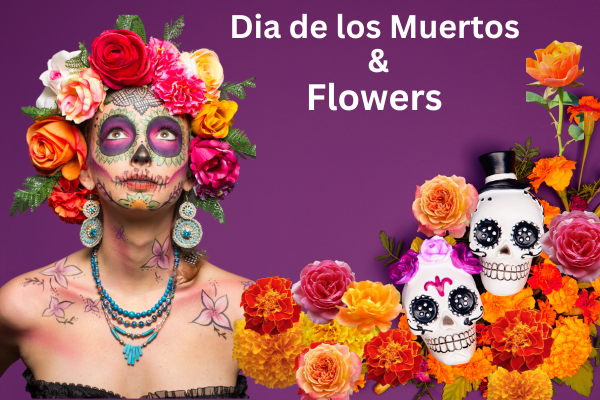Flowers play a significant role in the Dia de los Muertos, or Day of the Dead, celebrations, which is a traditional Mexican holiday on November 1st, that honors and remembers deceased loved ones. They hold cultural, symbolic, and spiritual importance in various ways:
- Marigolds (Cempasúchil): Marigolds are perhaps the most iconic flower associated with Dia de los Muertos. They are believed to guide the spirits of the deceased back to the world of the living. People use marigold petals to create intricate pathways or arrangements leading to ofrendas (altars) and graves. The vibrant orange and yellow colors of marigolds are thought to represent the sun, which is a symbol of life and light.
- Mexican Marigold (Tagetes erecta): This particular type of marigold is native to Mexico and is often referred to as “cempasúchil.” The word “cempasúchil” comes from the Nahuatl language and means “twenty flowers,” a reference to the flower’s many petals. They are seen as a connection between the living and the dead.
- Other Flowers: Besides marigolds, other flowers are also used, such as lilies, roses, and gladiolas. These flowers are chosen for their beauty, fragrance, and symbolism. Lilies represent the restoration of innocence, roses signify love, and gladiolas symbolize strength and integrity.
- Fragrance and Attraction: The strong scents and vibrant colors of these flowers are believed to help attract the spirits of the deceased to the ofrendas and altars, where offerings of their favorite foods, beverages, and mementos are placed. It’s thought that the spirits are drawn to the earthly realm by the beauty and aroma of the flowers.

6, Symbolism of Life and Death: The juxtaposition of vibrant, living flowers with images of death and skeletons serves as a reminder of the cycle of life and death. Dia de los Muertos is not a somber occasion but a celebration of the lives of those who have passed, and the presence of flowers helps convey this sentiment.
7. Personal Connection: Families often choose flowers that were the favorites of their deceased loved ones, adding a personal touch to the celebrations. This creates a deeper connection to the memories and spirits being honored.
Flowers are used in various ways during the celebrations of Dia de los Muertos. This traditional Mexican holiday involves creating ofrendas (altars) to honor and remember deceased loved ones. Flowers play a central role in these ofrendas and the broader festivities, serving both aesthetic and symbolic purposes. Here are eight common ways in which flowers are used during Dia de los Muertos:
- Pathways of Petals: Marigold petals are used to create intricate pathways or patterns leading from the entrance to the ofrenda. It is believed that these petals guide the spirits of the deceased back to the world of the living.
- Floral Crosses and Wreaths: Flowers are used to create crosses or wreaths that are often placed on the ofrenda or at the gravesite. These floral arrangements symbolize the intersection of life and death, with the vibrant flowers contrasting the images of skulls and skeletons.
- Altar Decorations: Flowers are an essential part of the ofrendas, or altars, created in homes and cemeteries during Dia de los Muertos. They are carefully arranged with candles, incense, sugar skulls, food, and other offerings to create a welcoming and beautiful space for honoring and remembering the departed.
- Floral Skulls: Elaborate sugar skulls, or calaveras, are often adorned with real or artificial flowers. These decorative skulls are a prominent feature of Dia de los Muertos and are commonly used to represent deceased loved ones.
- Cemetery Decorations: In cemeteries, people decorate the graves of their departed family members with flowers. These floral offerings, along with candles and mementos, transform the cemetery into a place of beauty and remembrance.
- Garlands and Crowns: Floral garlands, wreaths, and crowns made of fresh or artificial flowers are worn by both participants and the images of the deceased on the ofrendas. These accessories symbolize the festive and celebratory nature of the holiday.
- Fragrance and Symbolism: The strong scents and vibrant colors of the flowers are believed to attract the spirits of the deceased to the ofrendas. The flowers also carry symbolic meaning; marigolds represent the sun and its life-giving properties, while other flowers may symbolize love, purity, or strength.
- Personalization: Families often choose flowers that were the favorites of the deceased individuals they are honoring. This adds a personal touch to the celebrations and demonstrates a deep connection to the memories of their loved ones.

Flowers, particularly marigolds and other colorful varieties, are an integral part of Dia de los Muertos, playing a crucial role in the aesthetics, symbolism, and spiritual aspects of the celebration. They help create a visually stunning and fragrant environment that pays homage to those who have passed away while also celebrating the continuity of life. They serve as a bridge between the realms of the living and the dead, playing an essential role in celebrating the lives of those who have passed while emphasizing the cyclical nature of life and death.


Recent Comments